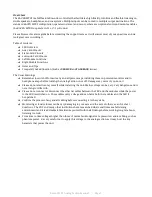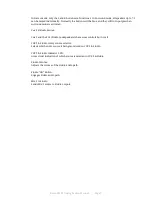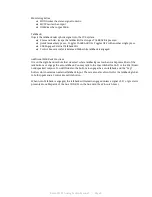
Notes and tips
Notes and tips on using the Cue System
Properly used, the Cue System can really improve your workflow. You will notice the available sends on the
Cue Output Dsub are:
1. Cue 1 Left
2. Cue 1 Right
3. Cue 2 Left
4. Cue 2 Right
5. Cue A
6. Cue B
7. Cue C
8. Cue D
Cue 1
always
carries the signal present on the Mix 1 input.
Cue 2 is selectable on the left module. Your choices are:
1. Mix 1
2. Mix 2
3. Digi
4. iDock
5. Aux
6. Cue A/B
7. Cue C/D
Cue A, B, C and D are sent directly from the associated inputs on the Main Input Dsub.
ALL OF THESE SENDS ARE UNATTENUATED FROM YOUR SOURCE
Some example setups:
Stereo Headphone amp in tracking room
If you use a simple cue system, patch the Cue 2 outputs to the headphone amp in your tracking
room. This way, you can select if the artist hears your main mix, a cue mix you have created, or any
of the additional sources available.
2 Stereo Channel Headphone amp, such as a rackmount unit with a “main” input and an “aux” input
Often on these types of headphone amps the artist can “pan” between available sources. In this
instance, try sending them Cue 1 and Cue 2. This way, different musicians sharing the amp can pan
between the main mix and an alt mix you’ve created in your DAW or on your console.
Additionally with this setup you can easily do a “more me” mix, where you use Cue 2 as your main
input and Cue A/B as the aux in. With this arrangement you can send an individual source relevant
to the artist down the A/B line, and they can balance it against the main mix to their liking. Also, take
a look at the sources available on Cue 2 (Left Hand Module). Great artist headphone options!
Multichannel Headphone System
With a multichannel system, you can easily send all the available sources. A typical setup might look
like this:
1. Cue 1 - (Stereo) Main Mix
2. Cue 2 - (Stereo) Alt Mix
3. Cue A - (Mono) Vocal
4. Cue B - (Mono) Kick & Snare
5. Cue C - (Mono) Solo Instrument
6. Cue D - (Mono) Click Track
In this setup even an eight-channel headphone system can provide a very flexible monitoring
system. In the control room you can easily monitor all these sources.
Raven MTX2 Analog Section Manual
Page 10































